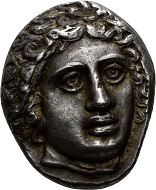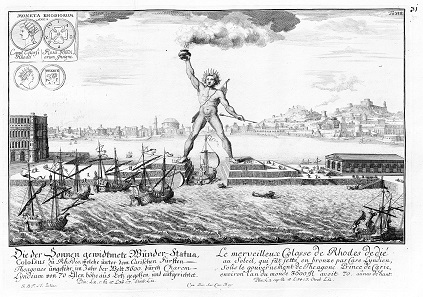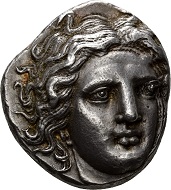Rhodes lay in the heart of the Mediterranean. Whenever merchants from the Greek mainland wanted to buy crops from Egypt, they had to pass Rhodes. When copper from Cyprus was shipped, Rhodes was a fixed stop on the way. Ships from all over the Mediterranean world anchored in the harbor of Rhodes, which had only been formed in 408 BC through a synoecism. Towards the end of the Peloponnesian War, the island’s smaller towns had decided to build a new, large capital together. When speaking of ancient Rhodes, we mean this new harbor town, created according to the Archidamian system for about 100,000 inhabitants.
Rhodes. Tetradrachm, 404-385. Head of Helios from the front, slightly turned to the right. Reverse: rose with bell-shaped bud on the right, on the field to the left an ear. Bérend 51 (this specimen). From Bérend collection. From Hess-Divo auction 334 (May 29th, 2018), No. 74. Extremely fine. Est.: CHF 25,000.
High above the harbor, the Rhodians erected a large temple for their protective god Helios. And of course, the Rhodians also honored their protector on their coins. Even the first tetradrachms of the young city, issued after 404 BC, show his image on the front. In auction 334 on May 29th, 2018, Hess-Divo will offer two examples of this type of coin in beautiful Late-Classical style.
Quadriga of Sol. Szechenyi Bad / Budapest. Photo: Pierre Bona / cc-by 3.0.
Even though everyone who visits the sun-drenched island in the Mediterranean Sea considers Helios an obvious choice, he is quite unusual as a city’s most important deity. Helios was no Olympian, but a Titan, son of Hyperion and Theia. Together with his sisters Selene (moon) and Eos (dawn), he ruled over the sky. During the day, he drove the chariot of the sun across the Oceanus, and at night returned to the East through the world-ocean, in order to bring back the light to the humans the next day.
Whereas the Olympians often interact with humans in the classical sagas we know, there are only a few stories where Helios plays at least a small role. We know him as the all-seeing, who tells Hephaestus that his wife Aphrodite cheated on him with Ares. We know him as the owner of the red cattle, the consumption of which brought great distress to Odysseus and his crew. And we know him as father of Phaethon, to whom he lent his sun chariot for a deadly drive. But that is about it.
For, in Classical times, Helios as god of the sun was almost completely replaced by Phoebus Apollo. And in such a way that he would become a philosophical ideal: Plato, in his Republic, calls him the symbolic child of the Form of the Good.
Copperplate engraving of the Colossus of Rhodes around 1580.
The living Helios cult on Rhodes is probably a remainder of the Doric settlement on the island. For, around 1000 BC, the Dorians immigrated to Rhodes. And in their settlements – we know this also from examples from Corinth, Sicyon, Argos, Sparta and Epidaurus – the Helios cult played quite a relevant role; a role which the tradition, highly influenced by Athens, most likely does not do justice.
At any rate, Rhodes was his most important place of worship. Here, Helios was revered with numerous specific rites. We know about a quadriga being pushed over a steep cliff into the sea, as an offering to him. An annual festival with famous competitions was held in honor of Helios. The highest priest of the sun god was simultaneously the eponymous official, i.e. the one after whom a year was named.
Copperplate engraving of the Colossus of Rhodes from 1721 – with coin images.
It was said on Rhodes that Helios had a deeply personal relationship with this island. Pindar writes that the Olympians divided the earth between them. Helios was absent at the time – after all, he had to drive the sun chariot across the sky – and therefore did not receive any land. When the sun god complained about it to Zeus, he gave him the island of Rhodes, which had not yet surfaced from the Oceanus.
Linked to Rhodes was also a female deity, Rhodos or Rhode, who was considered the wife of Helios. With her, he had seven sons, who would later become known as the mythical first rulers of the island.
Rhodes. Tetradrachm, 404-385. Head of Helios from the front, slightly turned to the right. Reverse: rose with bell-shaped bud on the right, on the field to the left a torch. Bérend 71 (this specimen). From Leu 83 (2002). From Hess-Divo auction 334 (May 29th, 2018), No. 71. Extremely fine. Est.: CHF 7,500.
Now Rhodes actually simply means rose. However, the reverse-side display on our tetradrachms goes far beyond the flower itself. What we like to dismiss as “canting arms” bore quite different aspects for the people of Rhodes: The rose is the link between the island and the god. It refers to the wife of Helios and the eternal covenant which the descendants of Helios and Rhodos had made with their god protector.
While many other ancient sites descended into insignificance during the Middle Ages, Rhodes, due to its strategic position, remained an important harbor and a station on the journey to the Holy Land. Wood engraving from 1487.
This covenant survived in the eyes of Rhodes’ inhabitants, because it had proven effective time and again throughout history: To cite only one example, when the Athenians, after the victory of Demetrius Poliorketes, let the latter live at the Acropolis and celebrated him as a new god, the town-wrecker failed, in 305, at the walls of Rhodes. The Rhodians had only one explanation for this: Their god Helios had proven himself more powerful than Demetrius. As a symbol for his power and as thanks to him, they built the famous colossal statue, which to this date is praised as one of the Seven Wonders of the Ancient World.
If you want to see all coins from the Hess-Divo sale, click here.











